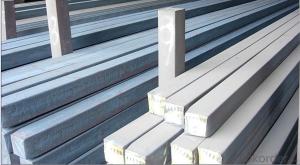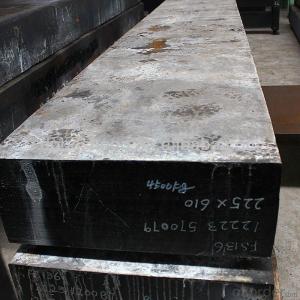Square Steel Billet Q235 Grade Prime Quality 8#
- Loading Port:
- Tianjin
- Payment Terms:
- TT OR LC
- Min Order Qty:
- 2000 m.t
- Supply Capability:
- 50000 m.t/month
OKorder Service Pledge
OKorder Financial Service
You Might Also Like
Description of Square Steel Billet Q235 Grade Prime Quality 8#
M. S. Billets are used for rolling of TMT Re-Bars of Fe415 and Fe500 Grade and various other structural steel products.
CRS Billets are used for rolling of CRS TMT Re-Bars.
Special Alloy Billets are used for rolling of any special grade TMT Re-Bars like Earthquake resistant TMT Re-Bars and for special grade structural steel products.
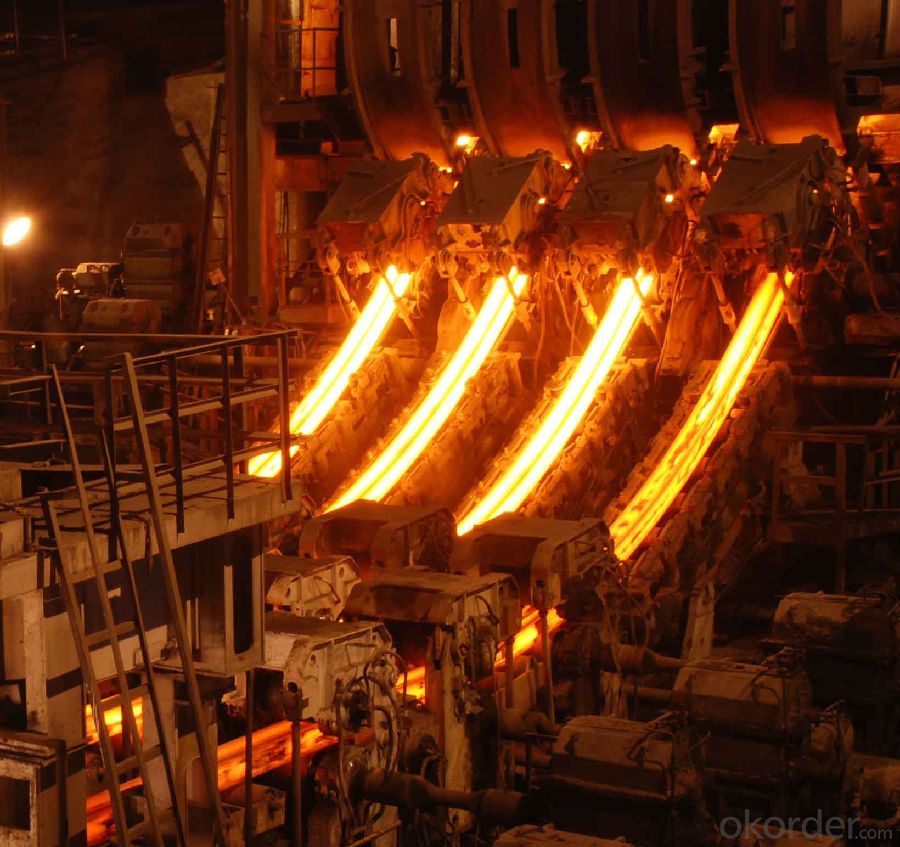
Main Feature Square Steel Billet Q235 Grade Prime Quality 8#
Raw elements(C,Fe,Ni,Mn,Cr,Cu.)---Smelted ingots by AOD finery---hot rolled into black suface---pickling in acid liquid---cold drawn----polished by automatically machine--- cutting into pieces---checking quanlity
Applications of Square Steel Billet Q235 Grade Prime Quality 8#
Widely Used in the areas such as Stainless Steel Fasteners, Chains, Kitchen and Sanitary wares, Furniture handles, Handrails, Electroplating and Electrolyzing pendants, Foods, Electron, Petroleum, Construction and Decoration, etc. Products have a high strength after cold-working. Electronic products parts, Medical appliance, Springs, Bus Inside and Outside packaging and building, Street Lamp Posts, etc. Decoration materials and Outdoor Publicity Billboard. Used for the products which have the Anti-Stress Corrosion requirement. Electron Products, Table-wares, Bolts, Nuts, Screen Meshes, Cumbustors and so on.
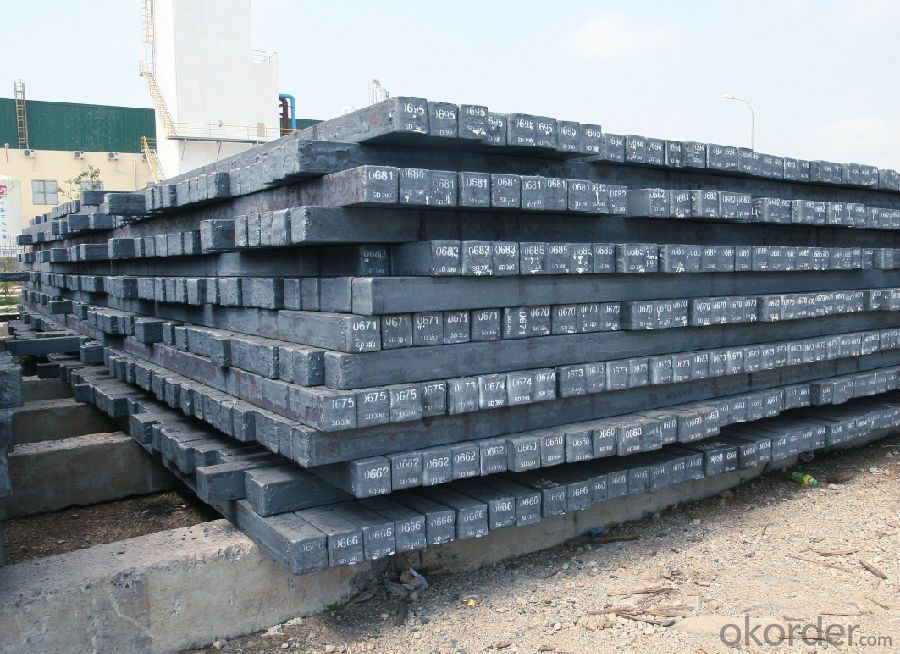
Specifications of Square Steel Billet Q235 Grade Prime Quality 8#
| Standard | C(%) | Mn(%) | S(%) | P(%) | Si(%) |
| Q195 | ≤0.12 | ≤0.50 | ≤0.040 | ≤0.035 | ≤0.30 |
| Q235 | ≤0.20 | ≤1.40 | ≤0.045 | ≤0.045 | ≤0.35 |
| Q275 | ≤0.22 | ≤1.50 | ≤0.045 | ≤0.045 | ≤0.35 |
| 20MnSi | 0.17-0.25 | 1.2-1.6 | ≤ 0.050 | ≤ 0.050 | 0.40-0.80 |
| 3SP | 0.14-0.22 | 0.40-0.85 | ≤ 0.050 | ≤ 0.040 | 0.05-0.15 |
| 5SP | 0.28-0.37 | 0.50-1.00 | ≤ 0.050 | ≤ 0.040 | 0.15-0.30 |
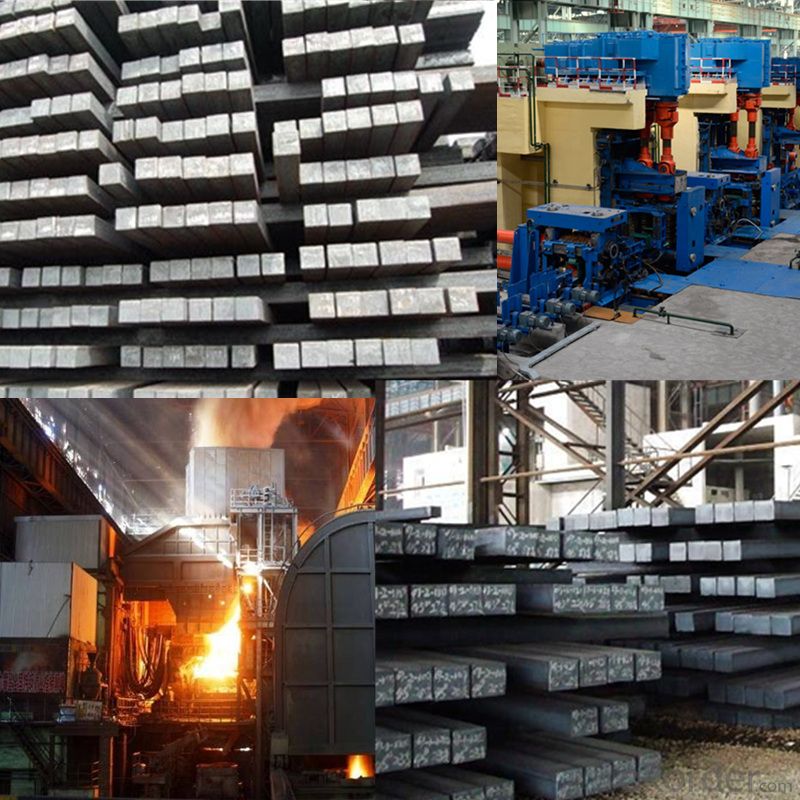
FAQ of Square Steel Billet Q235 Grade Prime Quality 8#
We have organized several common questions for our clients,may help you sincerely:
1. How Can I Visit There?
Our company is located in Tianjin City, China, near Beijing. You can fly to Tianjin Airport Directly. All our clients, from home or aboard, are warmly welcome to visit us!
2. How Can I Get Some Sample?
We are honored to offer you sample.
3. Why choose CNBM?
Our delivery time about 15-20days for standard sizes, if you have other requirements like hardness, quanity and width ,it is about 20-40days. But don't worry we also try our best for the delivery time ,because time longer and our cost is higher.
- Q:Can steel billets be used in the automotive industry?
- Yes, steel billets can be used in the automotive industry. Steel billets are semi-finished steel products that are typically used for further processing into different shapes and forms. In the automotive industry, steel billets are commonly used for the production of various automotive components such as engine parts, transmission parts, chassis components, and suspension systems. The use of steel billets in the automotive industry offers several advantages including high strength, durability, and cost-effectiveness. Additionally, steel billets can be easily formed, machined, and welded to meet specific design requirements and performance standards in the automotive sector. Therefore, steel billets play a crucial role in the manufacturing of automobiles and contribute to the overall performance, safety, and reliability of vehicles.
- Q:What is the role of steel billets in the construction of bridges and tunnels?
- The construction of bridges and tunnels heavily relies on steel billets, which are semi-finished steel products that undergo further processing to create various structural components for the construction industry. For bridges, steel billets are utilized to manufacture steel beams, girders, and columns, forming the core structure of the bridge. These components are essential for providing the required strength and stability to support the bridge's weight and the traffic it carries. Steel billets are chosen due to their high strength-to-weight ratio, making them ideal for constructing long-span and heavy-load bridges. Similarly, in tunnel construction, steel billets are used to create reinforcement bars or rebars. These rebars are embedded within the concrete walls and floors of tunnels, offering additional strength and support to withstand the immense pressure and weight of the surrounding soil or rock. Additionally, steel billets are also employed in fabricating tunnel linings, which protect the tunnel walls from erosion, corrosion, and other forms of deterioration. The utilization of steel billets in bridge and tunnel construction provides several advantages. Firstly, steel is a highly durable and resilient material, capable of withstanding extreme forces, temperature variations, and environmental conditions. This durability ensures the long-lasting nature and structural integrity of bridges and tunnels, reducing maintenance and repair costs over time. Secondly, steel billets can be easily shaped, molded, and welded into various intricate shapes and sizes, allowing for flexibility in design and construction. This versatility enables engineers to create innovative and efficient bridge and tunnel structures, accommodating different architectural and engineering requirements. Lastly, steel billets are renowned for their excellent load-bearing capacity, making them suitable for high-traffic areas such as bridges and tunnels. They can withstand heavy loads and distribute the weight evenly, minimizing the risk of structural failure or collapse. In conclusion, steel billets play a crucial role in the construction of bridges and tunnels by providing the necessary strength, durability, and flexibility. They form the core structure of these constructions, ensuring their stability, longevity, and ability to withstand various environmental and operational challenges.
- Q:How are steel billets used in the manufacturing of packaging materials?
- Packaging materials often utilize steel billets due to their durability and strength. These billets, essentially semi-finished steel products, serve as the raw material for packaging products like cans, drums, and containers. To manufacture packaging materials, the steel billets are initially heated to a specific temperature, making them easily moldable. They then undergo a series of rolling mills, where they are flattened and elongated into the desired size and shape. This process, referred to as hot rolling, enhances the steel's mechanical properties and increases its strength. Once the steel billets have taken on the desired shape, they undergo further processing and coating to enhance their resistance to corrosion and create a smooth surface finish. The type of coating used, whether it be a layer of tin, lacquer, or polymer, depends on the specific packaging requirements. The final steel packaging materials offer a multitude of advantages. They are robust and sturdy, effectively protecting the products they contain. They are also impermeable to moisture, gases, and light, ensuring the freshness and preservation of the packaged goods. Moreover, steel packaging materials are completely recyclable, making them an environmentally-friendly choice for packaging solutions. In conclusion, steel billets play a crucial role in the manufacturing of packaging materials. Through shaping, rolling, and coating processes, these billets are transformed into resilient and durable packaging products that provide exceptional protection and preservation for a wide variety of goods.
- Q:What are the different methods of steel billet surface coating?
- There are several methods of steel billet surface coating, including hot-dip galvanizing, electroplating, powder coating, and thermal spray coating.
- Q:What is the billet price in China today?
- Building materials tend to be stable, the price is good to pick up the trend, the overall no big changes, specific to my steel network detailed inquiries, information here will be updated every day
- Q:What are the main differences between carbon steel and alloy steel billets?
- Both carbon steel and alloy steel billets are utilized in various industries, but they differ in several key aspects. The primary discrepancy between carbon steel and alloy steel billets lies in their composition. Carbon steel billets consist primarily of iron and carbon, with carbon content typically ranging from 0.05% to 2.1%. This renders carbon steel comparatively more cost-effective and easier to manufacture than alloy steel. Conversely, alloy steel billets incorporate additional elements like manganese, nickel, chromium, and molybdenum, which are added to enhance specific steel properties. These alloying elements confer upon alloy steel superior strength, hardness, and resistance to corrosion compared to carbon steel. Another significant distinction between carbon steel and alloy steel billets pertains to their mechanical properties. Carbon steel billets are widely recognized for their high ductility and ease of shaping or forming, making them suitable for applications requiring flexibility and effortless machinability. Conversely, alloy steel billets possess higher tensile strength, toughness, and wear resistance due to the presence of alloying elements. This renders alloy steel billets ideal for applications necessitating high strength and wear resistance, such as in the construction, automotive, and aerospace industries. Moreover, the heat treatment processes for carbon steel and alloy steel billets also vary. Carbon steel billets are frequently subjected to heat treatment to enhance their hardness and strength, with common treatments encompassing quenching and tempering. Conversely, alloy steel billets can undergo a broader range of heat treatment processes, including annealing, normalizing, and precipitation hardening. These heat treatments serve to optimize the properties of alloy steel billets for specific applications, such as increasing strength or improving machinability. In conclusion, the primary disparities between carbon steel and alloy steel billets lie in their composition, mechanical properties, and heat treatment processes. Carbon steel predominantly comprises iron and carbon, while alloy steel incorporates additional alloying elements. Carbon steel possesses high ductility and is easily shaped, whereas alloy steel boasts superior strength, hardness, and resistance to corrosion. The heat treatment processes for these two steel types also differ, with alloy steel affording a wider array of treatment options.
- Q:How are steel billets used in the production of gear blanks?
- Gear blanks are made from steel billets, which are essential for their production. Steel billets are long bars of steel that possess the necessary characteristics for gear manufacturing. These billets are made from high-quality steel and provide the material needed for creating gear blanks. To shape the gear blanks, the steel billets are heated to a specific temperature, making them easier to work with. Various forming processes, such as forging or extrusion, are then used to transform the billets into the desired shape of the gear blank. Once the gear blank is formed, it undergoes further machining processes to refine its shape, dimensions, and surface finish. This includes turning, milling, drilling, or grinding operations. Precise machining is necessary to meet the required specifications for the final gear product. The gear blanks produced from steel billets are the foundation for creating different types of gears, including spur gears, helical gears, bevel gears, or worm gears. These gear blanks undergo additional steps, such as heat treatment and surface hardening, to enhance their mechanical properties and increase their resistance to wear and fatigue. In conclusion, steel billets are crucial in the production of gear blanks as they provide the raw material for creating gears. Through heating, forming, and machining processes, the steel billets are transformed into gear blanks, which are then further processed to create the final gears used in various applications.
- Q:What are the potential applications of steel billets in the aerospace aftermarket?
- Steel billets have various potential applications in the aerospace aftermarket. These include the manufacturing of specialized components and parts for aircraft engines, landing gears, and structural frameworks. Steel billets can also be used for repairs and replacements of damaged or worn-out aerospace components, ensuring the continued safe and efficient operation of aircraft.
- Q:How are steel billets used in the manufacturing of electrical components?
- Steel billets are used in the manufacturing of electrical components as they provide a strong and durable base material. These billets are first heated and then shaped into various forms, such as rods or bars, which are further processed to create the desired electrical components. The steel's high conductivity and resistance to corrosion make it ideal for applications where electrical conductivity is crucial, ensuring reliable performance and longevity of the components.
- Q:Fish pole carbon cloth tcf. Vcf. Svf. Hcf. On behalf of what?
- CF: is the abbreviation of Carbon Fiber in English, which means carbon fiber in ChineseCarbon fiber index for T (ton), ordinary carbon cloth is generally 20T-30T.Domestic ordinary carbon fishing rod material is generally 24T carbon fiber cloth. The higher the T value, the higher the strength and elasticity of the material.
1. Manufacturer Overview |
|
|---|---|
| Location | |
| Year Established | |
| Annual Output Value | |
| Main Markets | |
| Company Certifications | |
2. Manufacturer Certificates |
|
|---|---|
| a) Certification Name | |
| Range | |
| Reference | |
| Validity Period | |
3. Manufacturer Capability |
|
|---|---|
| a)Trade Capacity | |
| Nearest Port | |
| Export Percentage | |
| No.of Employees in Trade Department | |
| Language Spoken: | |
| b)Factory Information | |
| Factory Size: | |
| No. of Production Lines | |
| Contract Manufacturing | |
| Product Price Range | |
Send your message to us
Square Steel Billet Q235 Grade Prime Quality 8#
- Loading Port:
- Tianjin
- Payment Terms:
- TT OR LC
- Min Order Qty:
- 2000 m.t
- Supply Capability:
- 50000 m.t/month
OKorder Service Pledge
OKorder Financial Service
Similar products
New products
Hot products
Related keywords

